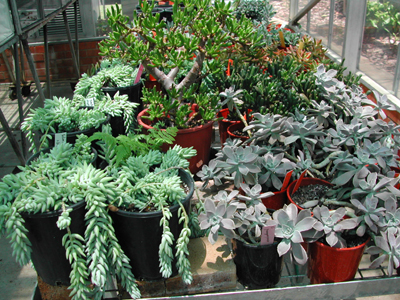The decision as to which plants are to be tested is discussed elsewhere
(See Compiling
a Plant List). For efficiency, plant species should be tested in a rational order with the species most at risk tested first. Wapshere
(1974) proposed a strategy in which the first step is to test a small group of plants that are very closely related and with morphological and biochemical similarities to the weed. This strategy allows early rejection of agents with a wide host range.
|

A range of plant species ready to be used in host
testing studies.
|
The plant material may be cut or living depending on the plant structure being tested, the size of the plant, the biology of the insect, the duration of the test, etc.
Plant material from different individual plants should be used for each replicate of the host-testing test. This gives more confidence in the results as broader genetic range within the plant species is being tested.
Oviposition and feeding preferences need to be understood and incorporated in designs of host range testing. The material provided from different plant species must be of equal suitability in terms of structure and ontogenetic development and a similar quantity of material must be provided. For example,
Coelocephalapion pigrae feeds and lays many more eggs into flower buds close to opening than less mature buds, therefore mature buds of all test species must be provided.
Chalcodermus serripes makes conspicuous feeding scars on pods of its host plant. Studies on the preferences for different plant parts showed that they prefer young leaves for feeding. A young leaf of every test plant species, therefore, had to be included in the tests. |

